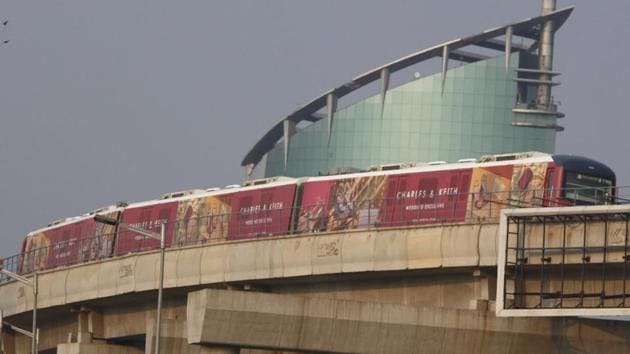Expensive mistakes: High cost, low ridership, location ensured failure of the Rapid Metro | Opinion
Annual report of 2017-18 reveals that Rapid Metro earned more from advertisement than passenger traffic. About 60% of revenue came from advertisements while traffic revenue was only 39%.
On Monday, the Punjab and Haryana High Court asked Infrastructure Leasing & Financial Services (IL&FS) Limited to operate and maintain the Gurugram Rapid Metro, country’s first fully privately-developed project, till September 17. The two special purpose vehicles (SPVs) of IL&FS— Rapid Metro Rail Gurgaon Limited (RMGL) and Rapid Metro Rail Gurgaon South Limited—that have been running the Rapid Metro in Gurugram since 2013 and 2017, respectively, have served their termination notices to state government stating an alleged breach of contract. Besides, the IL&FS is currently facing bankruptcy proceedings in the National Company Law Appellate Tribunal (NCLAT).

Simultaneously, there has been an ongoing debate in the city about how the inadequate coverage of Gurugram’s Metro Rail. People often compare Gurugram’s Metro network with that of cities such as Delhi, Bangalore, and Hyderabad, where it is more expansive. The suggestion from many is that a more expansive Metro network will not only improve local mobility, but will also encourage the city’s growth.
While on the one side there is an aspiration to have more Metro rail lines covering city’s every corner, on the other side, an existing link is facing closure. This doesn’t add up and mostly because Gurugram, like many other cities, is not looking at the Metro as a mobility project, but as a construction. Let me elaborate.
Location
The annual report of 2017-18 reveals that the Rapid Metro earned more from advertisement than passenger traffic. About 60% of the revenue came from advertisements while the traffic revenue was only 39%. This shows how insignificant the ridership is to the system. There are multiple reasons for it. However, the biggest issue is the project alignment. The phase I of Rapid Metro revolves around Cyber City, which is a work area, but not everyone working here lives around on the Rapid Metro line. The Phase 2 alignment along the Golf Course Road was a non-starter. This is because the area neither has density, nor mixed-income groups. On the other hand, the old Gurugram on the opposite side of NH48 has all the elements that could ensure high ridership, but doesn’t even have a single Metro line. Therefore, the alignment of Rapid Metro was chosen based on where it was easier to build rather than where it was needed.
Operations
The annual report also reveals that 65% of the operational cost was of financing. This against Delhi Metro’s 4% cost of finance and that of Bangalore at 13%. The cost of a privately funded project often jumps as publicly funded projects, such as the Delhi Metro, get cheap loans, courtesy agencies like the Japan International Cooperation Agency (JICA), World Bank, etc. However, the private sector has to borrow at commercial rates which can be 12-14%. This impacts the overall viability of the project. Therefore, while the city can take pride in getting a Metro at zero cost, it may work out in the long run. Therefore, it may be a better idea to look at a public-private partnership approach rather than dumping everything on a private operator.
Ecosystem
Let’s look at why people use the public transport? There could be many reasons, but fundamentally they either do it to save money or time. In the case of Rapid Metro, both these reasons don’t work. For example, under the Phase 2 Metro line lies a 16-lane road. Now it’s not rocket science to understand that it will be much faster to move on your motor vehicles than go to the Metro station, find parking, go through security checks, wait for the train to arrive, stop at multiple stations before reaching your destination. Similarly, people who want to save money will not use the Metro due to its high cost. For example, travelling from Sector 56 station to the next station which is a kilometre away will cost ₹20 in an auto. Yes, the fare will be same till Sikandarpur, but you can easily find shared autos or buses that will drop you at half this price. Therefore, both the main segments of transit users are not covered due to pricing and the way the Golf Course Road is designed.
Great cities around the world are neither known because of the kilometers of Metro network they have nor are they are known for how many of these kilometers were built by the private sector. These cities are known for the quality of the transport system they offer.
Gurugram should not fall into the trap of building more Metro lines just for the sake of it. Instead, the city should develop an overall mobility plan and choose the mode of transport accordingly. Some high-density corridors may need Metro, while others may be served by a high-quality city bus service.
(Amit Bhatt is the director- integrated transport, WRI India)






